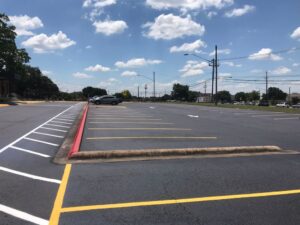 Asphalt is an excellent paving material with a wide variety of applications. Asphalt pavements are economical to install and repair, have a great deal of visual appeal and can last several decades with proper maintenance. However, no asphalt pavement is entirely impervious to damage. The damage can result from an error by the asphalt paving company that built the pavement, poor maintenance, improper drainage, or the effects of the sun, weather, traffic, and time. Identifying the type of damage your pavement has suffered can make it easier to understand the reasons behind your paving contractor’s recommendations.
Asphalt is an excellent paving material with a wide variety of applications. Asphalt pavements are economical to install and repair, have a great deal of visual appeal and can last several decades with proper maintenance. However, no asphalt pavement is entirely impervious to damage. The damage can result from an error by the asphalt paving company that built the pavement, poor maintenance, improper drainage, or the effects of the sun, weather, traffic, and time. Identifying the type of damage your pavement has suffered can make it easier to understand the reasons behind your paving contractor’s recommendations.
How to Identify Asphalt Pavement Damage
Why Has My Asphalt Pavement Turned Gray?
New asphalt pavement has a luxurious black color. Without proper maintenance, the color of asphalt pavement will fade to an unattractive shade of gray or brown. The primary cause of this fading is the UV radiation emitted by the sun. Fortunately, the solution is economical. An application of sealcoating every two years will restore the color and block the UV rays to prevent fading.
Why Does My Asphalt Pavement Have a Shiny Coating?
A shiny black coating indicates typically a condition that asphalt companies in Texas typically call bleeding or flushing. Bleeding can be messy, but it can also make the area too slick when wet. There can be several possible causes of bleeding, including an improper asphalt mix, too much sealant in joints or cracks, or an improper sealcoating mix. You should consult an Austin paving contractor to determine the cause and recommend the appropriate corrective action. In some instances, a coarse sand mixture applied over the pavement may soak up the excess binder. In other cases, the only way to correct the problem is by milling the existing surface and applying an asphalt overlay.
Why Have Bumps Formed in My Asphalt Pavement?
You may call them bumps, but an Austin paving company will probably call them swells. There are two common causes of pavement swells: clay in the underlying soil and frost heave. Clay soils expand when they are wet and contract when they are dry. Frost heave occurs when water trapped beneath the pavement freezes and expands. Occasionally, the accumulated moisture source may be a rise in the water table or a previously undetected underground spring. Still, swells are usually the result of cracks, potholes, or surface drainage issues that have gone uncorrected. The remediation of swells usually requires a full-depth patch.
Why Are There Low Spots in My Asphalt Pavement?
Asphalt paving contractors often refer to low spots or depressions in the pavement as birdbaths. You can quickly identify low spots after rain because water will collect in the depressions, and the pools will often remain for many hours after the rest of the pavement dries. One possible cause is an error in the installation process, but it is more likely the result of water that has eroded the base. Depending on the cause, your paving company may recommend milling the pavement to adjust the grade or installing an overlay.
What Causes Cracks in My Asphalt Pavement?
There are many different types of cracks and many various reasons for their development. For example, slippage cracks demonstrate that the surface layer did not bond properly to the layer below it or that the asphalt mix contained excessive sand. Remediation can require either a partial- or full-depth patch. Alligator cracking usually indicates an eroded base or an error in the installation or design of the pavement, and the repair will usually involve a full-depth patch. Edge cracks can result from poor drainage, excessive traffic, vegetation beside the pavement, or excessive drying of the underlying soil. In many cases, an asphalt company can repair edge cracks with a technique known as crack sealing. Still, it may also be necessary to remove nearby vegetation or improve the drainage.
Why Did My Asphalt Pavement Develop Potholes?
Potholes often result from base damage caused by water that has penetrated through unrepaired cracks or other breaks in the pavement’s surface. The pothole’s depth and girth can dictate the best repair method; some potholes can be filled or patched, but very large or numerous potholes may require the removal of the damaged area to repair the base before replacing the pavement with new asphalt.
Trust Alpha for the High-Quality Paving Austin TX Property Owners Need
Alpha Paving is the preferred asphalt paving company of Austin area businesses and municipalities. Our customers include property management firms, airports, healthcare facilities, retailers, religious institutions, apartment complexes, educational facilities, restaurants, manufacturing facilities, HOAs and condominium boards, and hotels. Our services include asphalt pavement construction, sealcoating, crack, and pothole repair, road construction, parking lot striping, asphalt milling, thermoplastic markings, concrete installation and repair, speed bump installation, and parking lot signs. We are known for providing outstanding customer service and exemplary work at affordable rates. Please request a free quote by filling out the online form or calling our office in Round Rock at 512-677-9001.




